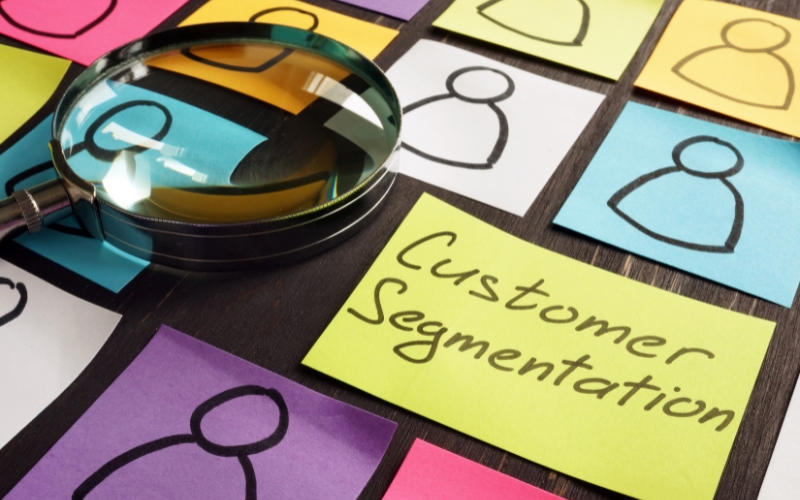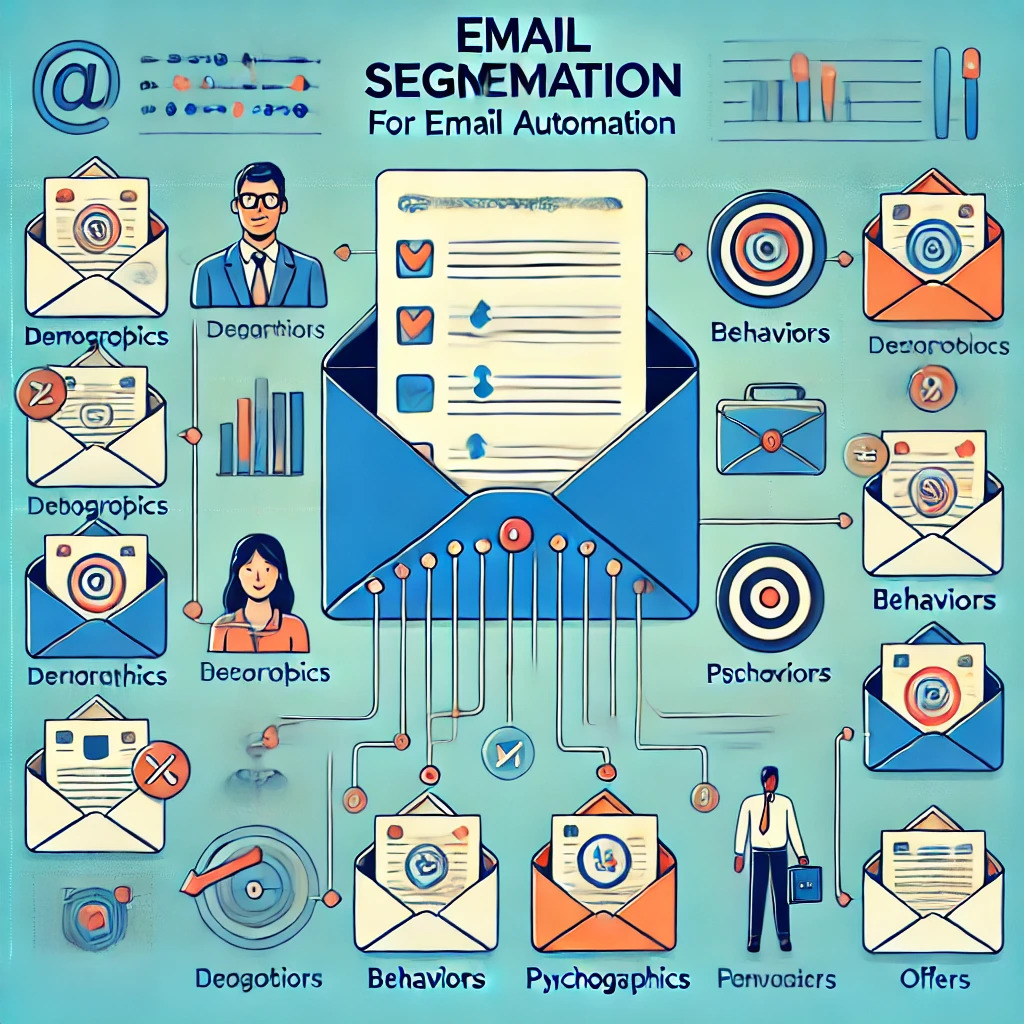Email segmentation is one of the most powerful tools for improving the effectiveness of your Email Automation Campaigns. By dividing your audience into smaller, more specific groups, you can ensure that the right content reaches the right people. This targeted approach not only boosts engagement but also enhances the overall user experience by delivering more relevant, personalized content. In this article, we’ll explore why segmentation is crucial for Email Automation Campaigns, the different types of segmentation you can use to optimize your strategy, and best practices to ensure you’re implementing segmentation effectively to drive better results.
Understanding Segmentation: Why It’s Essential for Effective Email Campaigns

Email segmentation is the practice of dividing your email list into smaller, more specific groups based on various characteristics or behaviors. Instead of sending a generic message to your entire list, segmentation enhances Email Automation Campaigns by tailoring your content and offers to specific audience groups. This approach ensures that the right message reaches the right people, leading to higher engagement and conversions.
What Email Segmentation Is and How It Improves Targeting in Email Automation Campaigns
Email segmentation is all about targeting specific audiences with relevant content. Imagine you run an e-commerce store that sells clothing. By segmenting your email list, you could create groups such as “men’s clothing buyers,” “women’s clothing buyers,” and “frequent shoppers.” This way, Email Automation Campaigns can deliver tailored offers, such as discounts on specific categories of clothing, to each group. Without segmentation, you would be sending the same message to everyone, regardless of their interests or past purchases, resulting in lower engagement.
Segmentation improves targeting by allowing Email Automation Campaigns to create personalized and relevant experiences for each subscriber. Rather than relying on a one-size-fits-all approach, segmentation helps deliver more meaningful content that resonates with each individual. When your Email Automation Campaigns align with a recipient’s preferences, needs, or behavior, you increase the chances of engagement, such as opening the email, clicking on links, or making a purchase.
How Segmentation Increases Engagement by Sending Relevant Content Through Email Automation Campaigns
One of the biggest advantages of email segmentation is the increase in engagement it drives. When people receive emails that speak directly to their interests, they’re more likely to interact with the content. For example, if Email Automation Campaigns send a special promotion on “summer dresses” to customers who have previously purchased women’s clothing, it’s more relevant and personalized than sending the same message to your entire list, which may include people who have no interest in dresses.
Segmentation helps businesses send the right message at the right time. For instance, Email Automation Campaigns can segment based on purchase history, recent activity on your website, or customer preferences. A customer who has abandoned a shopping cart might receive a reminder email with a personalized offer, while a repeat customer could receive a special loyalty reward.
By sending content that directly matches the recipient’s behavior or preferences, Email Automation Campaigns significantly increase engagement rates, which often leads to higher open rates, click-through rates, and conversions.
The Difference Between Broad Email Lists and Segmented Lists in Email Automation Campaigns
A broad email list typically consists of all subscribers lumped together, without consideration for their individual characteristics or behaviors. Sending generic content to this type of list often results in lower engagement, as it doesn’t address the specific needs of each subscriber.
In contrast, segmented lists are broken down into smaller, targeted groups based on criteria like demographics, past purchase behavior, or engagement with previous emails. These segmented groups allow Email Automation Campaigns to craft highly relevant messages for each audience, which is much more effective in driving engagement and conversions.
By focusing on segmented lists, businesses can maximize the relevance of their Email Automation Campaigns, leading to better results and a stronger relationship with their subscribers.
In conclusion, email segmentation is a powerful tool that enhances targeting, increases engagement, and improves the overall effectiveness of Email Automation Campaigns. By understanding and implementing segmentation, you can deliver more personalized, relevant content that resonates with each subscriber, driving higher conversions and building stronger customer loyalty.
Types of Segmentation: How to Divide Your Audience for Maximum Impact

To create effective Email Automation Campaigns, segmentation is crucial in delivering personalized content that resonates with your audience. There are several types of segmentation that allow you to divide your email list into meaningful categories. By targeting specific groups based on different criteria, you can increase engagement, improve conversions, and ultimately build stronger relationships with your customers. Let’s explore three key types of segmentation: demographic, behavioral, and psychographic.
Demographic Segmentation: Age, Gender, Location, and Its Benefits
Demographic segmentation involves categorizing your audience based on basic characteristics like age, gender, income level, and location. This is one of the simplest and most commonly used forms of segmentation, as it allows you to send content that is tailored to these factors through your Email Automation Campaigns.
For instance, a clothing brand can segment its email list by gender to send personalized promotions or new arrivals that are more relevant to each group. Similarly, segmenting based on age can help a company target specific life stages or preferences—sending different styles or offers to younger adults versus older customers. Geographic segmentation is especially powerful for businesses with physical locations, as you can tailor messages for different regions, offer location-based discounts, or highlight nearby events.
The primary benefit of demographic segmentation is that it allows you to reach your audience in a way that feels personal and relevant, leading to higher open and click-through rates in Email Automation Campaigns.
Behavioral Segmentation: Tailoring Content Based on Past Actions
Behavioral segmentation takes things a step further by focusing on a customer’s past actions, such as their interaction with previous emails, website visits, purchases, and even abandoned carts. This type of segmentation provides valuable insights into customer intent and allows you to send highly targeted content through Email Automation Campaigns based on what they’ve already shown interest in.
For example, if a customer opens multiple emails about a particular product but never makes a purchase, you can follow up with a targeted offer, discount, or reminder to encourage them to complete their purchase. Similarly, if someone has abandoned their shopping cart, you can send a reminder email with personalized incentives to drive them back to the site.
Behavioral segmentation helps you optimize your Email Automation Campaigns by sending the right message to the right person at the right time, based on their actions.
Psychographic Segmentation: Understanding Customer Interests, Values, and Lifestyles
Psychographic segmentation goes beyond basic demographics and behavior, diving deeper into understanding your customers’ lifestyles, values, and interests. This type of segmentation allows you to align your Email Automation Campaigns with your audience’s motivations, desires, and attitudes.
For instance, if you know that certain segments of your audience are eco-conscious, you can tailor your emails to promote sustainable products or share eco-friendly practices your brand follows. Similarly, a fitness brand can segment its audience based on interests in specific activities like yoga, running, or weight training, sending customized workout tips, offers, or content that appeals to each group.
Psychographic segmentation creates more meaningful and emotional connections with your audience, as you are speaking directly to their values and interests, fostering a deeper relationship with your brand through effective Email Automation Campaigns.
By leveraging demographic, behavioral, and psychographic segmentation, you can ensure your Email Automation Campaigns consistently deliver relevant, engaging, and targeted messages to your audience, driving both loyalty and conversions.
Best Practices for Implementing Segmentation in Your Email Automation Strategy

Effective email segmentation is key to optimizing your email automation strategy. By organizing your audience into well-defined groups, you can send more personalized, relevant messages that resonate with each recipient. However, segmentation isn’t just about creating lists—it’s about collecting the right data, designing customized email workflows, and measuring the impact of your campaigns. Here’s how to implement segmentation best practices for email automation.
1. Tips for Collecting the Right Data for Segmentation
Before you can segment your email list, you need to collect the right data. The quality and accuracy of your segmentation rely on the information you gather from your subscribers. There are several ways to collect data effectively:
- Use Signup Forms: When new subscribers sign up for your emails, include custom fields in your signup forms to gather specific information such as age, location, or interests. This enables you to segment your list early on and send targeted messages right from the start.
- Track Website Behavior: Use tracking tools to monitor how users interact with your website, including the pages they visit and products they view. This behavior data can help you segment based on their interests or buying intent, allowing you to send tailored messages or offers.
- Leverage Purchase History: If you operate an e-commerce business, track customer purchase history and segment based on their previous purchases. For example, sending an email with complementary products or accessories to someone who has purchased a particular item can increase the likelihood of repeat sales.
- Engagement Data: Monitor how subscribers interact with your emails. Those who open, click, or engage with specific types of content can be segmented into groups, allowing you to refine your messaging based on their engagement patterns.
By collecting this type of data, you can create a more targeted and relevant email experience for your subscribers.
2. How to Create Personalized Email Workflows Based on Segmented Lists
Once you’ve segmented your audience, the next step is to design personalized email workflows for each group. Personalized workflows allow you to send the right message to the right person at the right time, improving engagement and conversions. Here’s how to create these workflows:
- Create Triggered Emails: Set up automation triggers based on specific actions. For example, send a welcome email series to new subscribers, a follow-up email to those who abandoned their shopping cart, or a birthday email with a special discount.
- Tailor Content for Each Segment: Develop email content that speaks directly to each segment’s needs, interests, or past behavior. For example, send product recommendations based on their browsing history, or personalized offers for repeat customers.
- Dynamic Content Blocks: Use dynamic content blocks to tailor different sections of an email for different segments. For example, you could have a general message but show different products or promotions depending on the subscriber’s previous purchases or interactions.
Personalized workflows help build stronger relationships with your subscribers by ensuring they receive content relevant to them, increasing the likelihood of conversion.
3. Measuring the Success of Your Segmented Email Campaigns
Once you’ve implemented segmentation and personalized email workflows, it’s important to measure the success of your campaigns to ensure your efforts are paying off. Key performance indicators (KPIs) such as open rates, click-through rates (CTR), and conversions can provide valuable insights into how well your segmented campaigns are performing:
- Open Rates: Monitor how many recipients open your emails. A higher open rate indicates that your subject lines, timing, and segmentation strategy are effective in catching your audience’s attention.
- Click-Through Rates (CTR): Track how many recipients click on links within your emails. This measures the effectiveness of your email content and whether it resonates with the audience. High CTRs suggest that your segmentation and personalized content are engaging.
- Conversions: Ultimately, the goal of any email campaign is to drive conversions—whether it’s a purchase, sign-up, or other desired action. Tracking conversions helps you determine whether your segmented emails are driving the desired results.
By regularly analyzing these metrics, you can identify which segments and strategies are most effective, allowing you to refine your email automation strategy for even better performance.
Conclusion
In conclusion, email segmentation is essential for creating more personalized, targeted email campaigns that lead to higher engagement and conversions. By understanding and implementing the right segmentation strategies—whether demographic, behavioral, or psychographic—you can deliver relevant content to your audience, increasing the chances of success for your campaigns. Additionally, following best practices for collecting data, designing personalized workflows, and measuring performance ensures that your segmented campaigns continually improve. Mastering segmentation will not only help you connect more effectively with your subscribers but also optimize your email automation strategy for long-term success.

